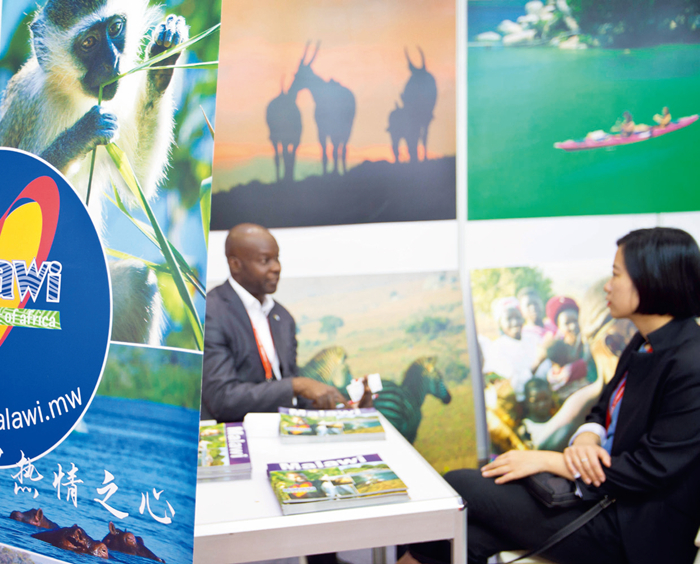|
||||||||||
| Home Nation World Business Opinion Lifestyle ChinAfrica Multimedia Columnists Documents Special Reports |
|
||||||||||
| Home Nation World Business Opinion Lifestyle ChinAfrica Multimedia Columnists Documents Special Reports |
| ChinAfrica |
| Malawi 2063 Takes Off |
| Bold bid launched to reach upper middle-income status in next four decades |
| Reporting from Malawi EDWIN NYIRONGO 丨VOL. 14 JANUARY 2022 ·2022-01-21 |

Malawian President Lazarus Chakwera (left) receives the Malawi 2063 First 10-Year Implementation Plan document (MALAWI NEWS AGENCY)
In his keynote speech, Chakwera described the event as the country’s way of heeding the wisdom of the Chinese proverb, “A journey of a thousand miles begins with a single step.”
The MIP-1, to run from 2021 to 2030, replaces the Malawi Growth and Development Strategy III as the country’s new medium-term development strategy. Its goal is to assist Malawi to reach middle-income economy status and meet the majority of Sustainable Development Goals by 2030, which will require an estimated $15 billion in funding.
It also projects that if the economy grows at an annual average rate of 6 percent, Malawi could attain the lower middle-income status by 2030.
A lower middle-income country is classified by the World Bank as having attained a gross national income per-capita range between $1,036 and $4,045 per annum. MIP-1 identifies “quick wins,” which are interventions that are already in the pipeline or have low-cost implications or just require scaling-up in the next five years.
According to the MIP-1 blueprint document, funding is to come from sources that include external grants, sustainable domestic and international debt, public-private partnerships and other regional and international financing mechanisms.
Agriculture driven
The 210-page document targets a per-capita annual income of $1,000 by 2030, a similar target that was not met by the predecessor document, Vision 2020.
Currently, Malawi’s per-capita income, which is derived by dividing national income by population, is ranked one of the lowest in the world at around $600.
But from the onset, MIP-1 appears to be ambitious. For example, the document says the plan is to grow the share of agriculture, forestry and fishing to gross domestic product (GDP) from 22.8 percent in 2020 to about 30 percent in 2030.
Agricultural productivity and commercialization are the first pillar of the Malawi 2063, and make up Malawi’s second long-term national development plan, replacing Vision 2020.
According to MIP-1, the agriculture sector is already enjoying huge financial support from both the government and development partners.
The president is reported to have emphasized the need to digitize farming in order to make it more efficient and more productive, according to a report by the Xinhua News Agency.
“We need to re-educate our youth to understand that farming is one of the surest paths to the wealth and prosperity they desire,” said President Chakwera at the MIP-1 launch.
He called on young people in the country’s colleges and universities to be aspiring either to use their education to make the country’s farming smarter, or to use farming as a foundation for building wealth.
The MIP-1 also acknowledges that the agricultural sector enjoys spillover benefits from the implementation of strategies and programs in cross-cutting areas such as climate change, land and environmental management.
However, production and productivity of the sector has remained below its potential and is insufficient to match the increasing demand from domestic and export markets. Despite the high dependence of the economy on agriculture, commercialization of the sector is limited.
“Overall, the sector is characterized by low productivity, low levels of improved farm input use, limited private investment and low mechanization levels,” says MIP-1 document.
Providing comparative statistics, the document reveals that the average added value per agricultural worker in Malawi has only amounted to $209, far below the Sub-Saharan average of $680.
Similarly, in 2019, Malawi’s score in the Enabling the Business of Agriculture Index, a publication issued by the World Bank to measure how regulations affect the livelihood of domestic farmers, was very low at 41.51 out of 100.

A Malawian official talks with a visitor in a travel mart in Beijing. Tourism has been an important sector Malawi relies on to develop its economy (VCG)
Ambitious plan
From the industrialization point of view, MIP-1 aims to improve the share of manufacturing to GDP from 9.1 percent in 2020 to at least 13 percent by 2030. Similarly, the share of mining to GDP will increase from 0.8 percent in 2020 to at least 10 percent in 2030, while the share of export of non-agricultural products to total exports is expected to improve from 20 percent in 2020 to at least 25 percent by 2030.
Currently, Malawi’s industrial base is very narrow. During the past decade, the share of manufacturing to GDP grew from 10.7 percent in 2013 to about 12.2 percent in 2020. Industrialization has stagnated mainly because of high production costs due to, among others, inefficiencies in energy and transport and poor standards leading to non-competitive products on international markets.
Economist Betchani Tchereni from the Malawi University of Business and Applied Sciences described Malawi 2063 as an ambitious plan that can benefit the country if well executed.
“It is an ambitious document with very specific goals that we want. For us to achieve this, we need to be disciplined and sacrifice a number of our egos. There is a need for a collective approach because we must all understand that it is for the future,” said Tchereni.
He, however, noted that since the country has a specific goal, there is also a need to follow specific plans and clearly state how the country wants to get to its destination.
During a panel discussion organized by Malawi’s National Planning Commission, held on the sidelines of the National Development Conference, Ngabaghila Chatata, one of the panelists who is also the managing director of Thanthwe Holdings Ltd., lamented that over the years, Malawi’s agriculture sector has been struggling to succeed as a result of poor implementation of policies, as well as misallocation of resources within the sector.
Comments to hufan@chinafrica.cn
| About Us | Contact Us | Advertise with Us | Subscribe |
| Copyright Beijing Review All rights reserved 京ICP备08005356号-5 京公网安备110102005860号 |